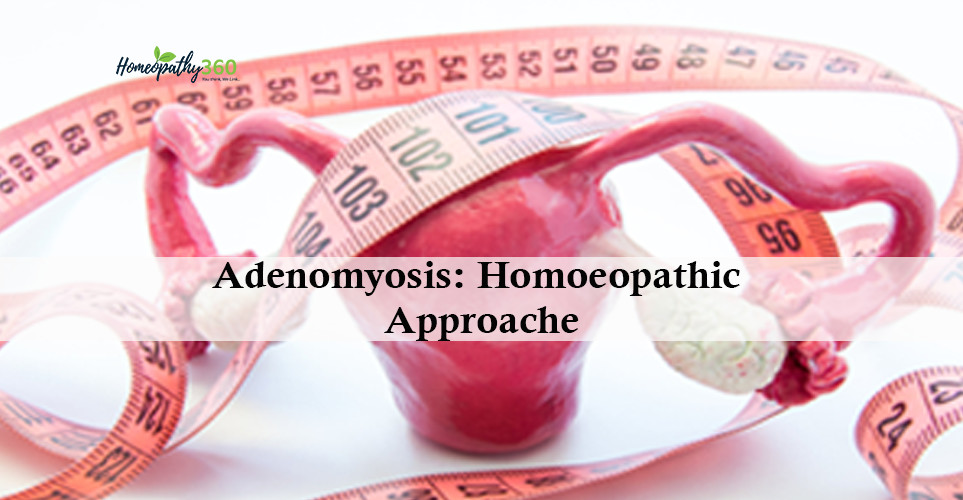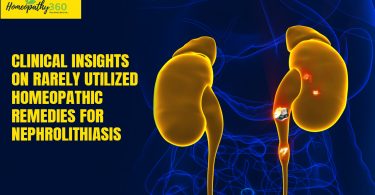
Abstract:
Adenomyosis is a medical condition characterized by the presence of endometrial tissue within the muscular wall of the uterus, leading to various debilitating symptoms such as heavy menstrual bleeding, pelvic pain, and discomfort. This condition poses significant challenges in conventional treatment, prompting an exploration of alternative therapies, including homoeopathy.
Keywords: Adenomyosis, homoeopathy
Introduction
Definition
Adenomyosis is a medical condition characterized by the presence of endometrial tissue, which normally lines the uterus, growing into the muscular wall of the uterus (myometrium). This condition typically occurs in the innermost layer of the uterus and can lead to the thickening of the uterine walls. Adenomyosis can cause symptoms such as pelvic pain, menstrual cramps, heavy menstrual bleeding, and an enlarged uterus.
Causes
The exact cause of adenomyosis is not well understood, and it may involve a combination of genetic, hormonal, and environmental factors. Here are some factors that are believed to contribute to the development of adenomyosis:
Hormonal Influence: Hormones, particularly estrogen, play a crucial role in the growth and shedding of the endometrial lining during the menstrual cycle. An imbalance in hormonal levels, particularly an excess of estrogen, may contribute to the development of adenomyosis.
Inflammation: Chronic inflammation in the uterine lining or in the pelvic area may be associated with the development of adenomyosis. Inflammation could create an environment that allows the infiltration of endometrial tissue into the muscular wall of the uterus.
Childbirth: Women who have given birth may have a higher risk of developing adenomyosis. The stretching and tearing of the uterine tissue during childbirth might create conditions that facilitate the invasion of endometrial cells into the uterine muscle.
Invasive Procedures: Certain medical procedures, such as uterine surgery (including Cesarean sections) and diagnostic procedures like dilation and curettage (D&C), might increase the risk of adenomyosis by providing pathways for endometrial tissue to invade the uterine walls.
Genetic Factors: There may be a genetic predisposition to adenomyosis, as it sometimes appears to run in families. However, the specific genes involved are not yet well defined.
Symptoms
Adenomyosis can cause a variety of symptoms, and their severity can vary among individuals. Some women with adenomyosis may experience no noticeable symptoms, while others may have significant discomfort. Common symptoms of adenomyosis include:
Menstrual Pain (Dysmenorrhea): Women with adenomyosis often experience intense menstrual cramps that are more severe than typical menstrual discomfort. The pain may start before menstruation and persist throughout the period.
Pelvic Pain and Discomfort: Persistent pelvic pain or a feeling of heaviness in the lower abdomen is a common symptom. This discomfort may not be limited to the menstrual period and can occur at any time.
Heavy Menstrual Bleeding (Menorrhagia): Adenomyosis can lead to heavier than normal menstrual bleeding. Some women may notice an increase in the duration and amount of blood flow during their periods.
Enlarged Uterus: The presence of adenomyosis can cause the uterus to become enlarged. This enlargement may be detected during a pelvic examination.
Painful Intercourse: Some women with adenomyosis may experience pain or discomfort during sexual intercourse.
Back Pain: The pelvic pain associated with adenomyosis may radiate to the lower back.
Irregular Menstrual Cycles: Adenomyosis may contribute to irregular menstrual cycles in some cases.
Physical examination
Medical History:
The healthcare provider will begin by taking a detailed medical history, including information about your menstrual cycles, symptoms, and any relevant medical conditions.
Be prepared to discuss the nature, duration, and severity of your symptoms, including pelvic pain, menstrual cramps, and abnormal bleeding.
Pelvic Examination:
A pelvic examination is a crucial part of the evaluation for adenomyosis. During the examination, your healthcare provider will:
Feel the size and shape of the uterus: Enlargement and changes in the consistency of the uterus may be indicative of adenomyosis.
Assess tenderness: Adenomyosis can make the uterus tender to the touch.
Rule out other conditions: The healthcare provider will also check for other possible causes of symptoms, such as fibroids or ovarian cysts.
Investigations
Ultrasound
Magnetic Resonance Imaging (MRI)
Homoeopathic therapeutics
It appears you are referring to a specific list of homeopathic medicines that are commonly considered for adenomyosis based on symptomatology. While I understand your interest in exploring homeopathic options, it’s important to note that the effectiveness of homeopathy is a subject of ongoing debate within the medical community, and the scientific evidence supporting its use for adenomyosis is limited.
A) Menorrhagia
B) Dysmennorhea
C) Dyspareunia
D) Frequent urination
E) Infertility
F) Other characteristic symptoms
Belladonna:
This remedy is sometimes suggested for individuals with severe pelvic pain, a throbbing sensation in the uterus, and an enlarged, tender uterus.
Sepia:
Sepia may be recommended for women experiencing dragging or bearing-down sensations in the pelvis, accompanied by a sense of heaviness. It is often prescribed when there is an aversion to sex and a feeling of irritability.
Lachesis:
Lachesis may be considered when there is intense pain and tenderness in the uterine region, and symptoms worsen during the menstrual period. It is also used for women who feel relief from pain after the flow becomes established.
Calcarea Carbonica:
This remedy may be indicated for women who have heavy menstrual bleeding, especially in the perimenopausal period, along with a feeling of coldness and fatigue.
Arsenicum Album:
Arsenicum is often suggested for women experiencing sharp, burning pains in the pelvis and a sense of restlessness and anxiety. It may be used when symptoms worsen at night.
Thuja Occidentalis:
Thuja may be considered for women with adenomyosis who have a history of hormonal imbalances or exposure to hormonal treatments.
Nux vomica:
Menses too early, lasts too long; always irregular, blood black withfaint spells. Dysmenorrhoea, with pain in sacrum, and constant urging to stool.
Secale cor:
Menses irregular, copious, dark; continuous oozing of watery blood until next period. Passive haemorrhages in feeble, cachectic women. Menstrual colic, with coldness and intolerance of heat. Burning pains in uterus. Threatened abortion about the third month.
Apis melifica:
Metrorrhagia profuse, with heavy abdomen, faintness, stinging pain. Dysmenorrhoea, with severe ovarian pains. Soreness and stinging pains; Sense of tightness. Bearing-down, as if menses were to appear.
Medorrhinum:
Menses offensive, profuse, dark, clotted; stains difficult to wash out. Intense menstrual colic. Sensitive spot near os uteri. Sterility. Urinates frequently at the time of menstruation.
Pyrogenium
Uterine haemorrhages. Menses horribly offensive. Fever at each menstrual period, consequent upon latent pelvic inflammation.
References
- Konar Hiralal. DC Dutta’s Textbook of Gynecology. Enlarged & Revised Reprintof Sixth Edition. New Delhi: Jaypee Brothers Medical Publications (P) Ltd, 2013.
- Boericke W. Pocket Manual of Homoeopathic Materia Medica and Repertory. 9th Edition. New Delhi: B. Jain Publishers (P) Ltd, 2009
- Robin Murphy. Lotus Materia Medica 3rd Edition, B.Jain Publishers Pvt Ltd., 1 June 2010, 2220.
- Dr S.C. Ghose Drugs of Hindoosthan 8th , 342.
About the Author
Dr. Pramod Kumar Singh1 , Dr. Somendra Yadav2, Dr. Rishabh Dixit2, Dr. Ankita Srivastava3, Dr. Sakshi Sharma4, Dr. Pawan Choudhary4
- Professor, Department of Homoeopathic Pharmacy, Dr. M.P.K. Homoeopathic Medical College, Hospital and Research Centre, Jaipur, Rajasthan, India.
- MD Scholar, Department of Homoeopathic Pharmacy Dr. M.P.K. Homoeopathic Medical College, Hospital and Research Centre, Jaipur, Rajasthan, India.
- MD Scholar, Department of Materia Medica, Dr. M.P.K. Homoeopathic Medical College, Hospital and Research Centre, Jaipur, Rajasthan, India.
- MD Scholar, Department of Practice of Medicine Dr. M.P.K. Homoeopathic Medical College, Hospital and Research Centre, Jaipur, Rajasthan, India.





